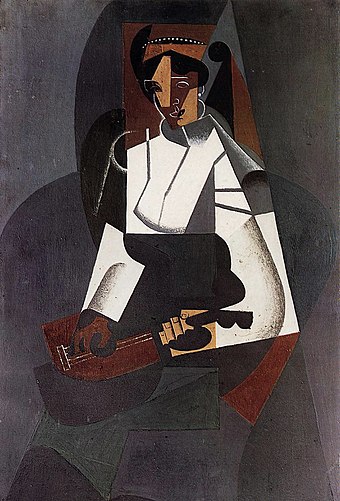Cubism is an avant-garde movement formed in Paris in the early 20th century. The earliest pioneers of the movement were Pablo Picasso and Georges Braque, who were later joined by the likes of Jean Metzinger, Albert Gleizes, and Juan Gris. In cubism artwork, elements of the subject are broken down to basic geometric shapes to portray a more abstract form. The use of multiple view points also provides more context to the work; this technique is clearly seen in the portraits by Pablo Picasso where the subjects side and front profile are seen in the same view. Later cubism works focused more on larger overlapping geometric shapes with greater contrast highlighting each individual shape, thus it was dubbed crystal cubism.
There are generally considered to be three phases of cubism: early cubism (1906-1908), high cubism (1909-1914), and late cubism (1914-1921). Early cubism was the first time multiple view points of the subject were brought into the same painting resulting in an abstract appearance. Paintings from this time period share elements with later cubist work, but often were more organic in shape and color. Often times a single color pallet was used across the entire painting to blend the subject with the back ground, and blur the boundary between the two. High cubism moved more towards the depiction of scenes and objects rather than people. Juan Gris was among the most famous high cubist artist, producing influential works and incorporating the use of papier collage into his work. This involved cutting geometric pieces of paper out and pasting them to the canvas, then sketching or painting over it to highlight certain elements. During high cubism, brighter colors and greater contrast were introduced as well as a shift towards pure geometric shapes. After world war I, cubism saw a shift towards a very strong emphasis on contrasting colors and overlapping large geometric shapes which marked the beginning of late cubism. The contrasting colors and lines between the subject and background added clarity to the paintings, which is in direct contrast with earlier works. Late cubism also saw a shift back towards a more traditional point of view, most pieces mainly used a single view point with small elements of the subject or background viewed from an alternative point.
Around 1920 the cubist avant-garde style was questioned by artists and critics as geometric abstraction became the favored style. Around the mid 1920’s almost all of the notable cubist artist began exploring different styles and quickly the cubist movement dies out.

Maison’s à Paris (Houses in Paris), 1911 Juan Gris.

Jean Metzinger, 1914–15, Soldat jouant aux échecs (Soldier at a Game of Chess, Le Soldat à la partie d’échecs)

Albert Gleizes, L’Homme au Balcon, Man on a Balcony (Portrait of Dr. Théo Morinaud)

Pablo Picasso, Les Demoiselles d’Avignon, 1907, considered to be a major step towards the founding of the Cubist movement

Juan Gris, September 1916, Woman with Mandolin, after Corot
Sources:
“Cubism.” Wikipedia, Wikimedia Foundation, 1 Feb. 2023, https://en.wikipedia.org/wiki/Cubism.
“Juan Gris.” Wikipedia, Wikimedia Foundation, 4 Nov. 2022, https://en.wikipedia.org/wiki/Juan_Gris.
Tate. “Cubism.” Tate, https://www.tate.org.uk/art/art-terms/cubism#:~:text=Cubism%20was%20a%20revolutionary%20new,that%20appear%20fragmented%20and%20abstracted.
“1909 To 1912.” Pablo Picasso’s Cubism Period, https://www.pablopicasso.org/cubism.jsp.

1 Comment. Leave new
I wasn’t familiar with the history of cubism before now and it was really interesting to learn about it. I wonder what influence cubism has had on art styles since its death. Does it have any close cousins or spiritual successors?